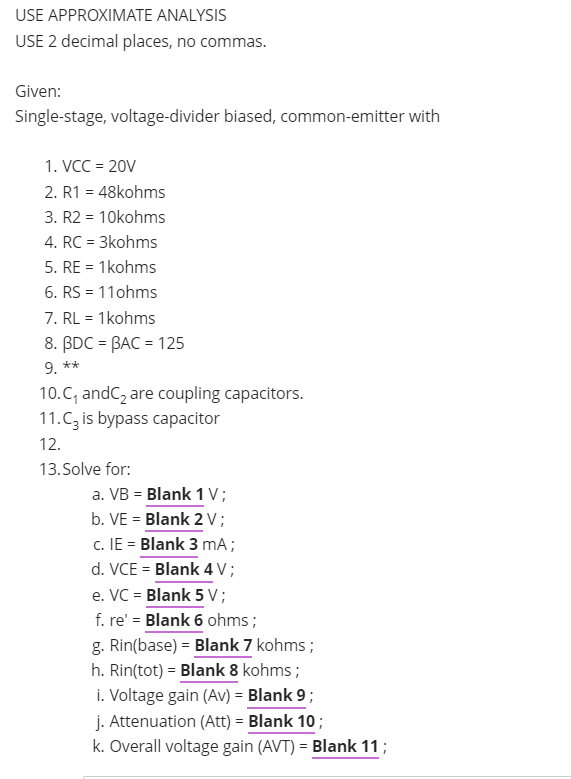USE 2 decimal places, no commas. Given: Single-stage, voltage-divider biased, common-emitter with 1. VCC = 20V 2. R1 = 48kohms 3. R2 = 10kohms 4. RC = 3kohms 5. RE = 1kohms 6. RS = 11ohms 7. RL = 1kohms 8. BDC = BAC = 125 9. ** 10.C, andC, are coupling capacitors. 11.C, is bypass capacitor 12. 13. Solve for: a. VB = Blank 1 V; b. VE = Blank 2 V; c. IE = Blank 3 mA; %3D d. VCE = Blank 4 V ; %3D
USE 2 decimal places, no commas. Given: Single-stage, voltage-divider biased, common-emitter with 1. VCC = 20V 2. R1 = 48kohms 3. R2 = 10kohms 4. RC = 3kohms 5. RE = 1kohms 6. RS = 11ohms 7. RL = 1kohms 8. BDC = BAC = 125 9. ** 10.C, andC, are coupling capacitors. 11.C, is bypass capacitor 12. 13. Solve for: a. VB = Blank 1 V; b. VE = Blank 2 V; c. IE = Blank 3 mA; %3D d. VCE = Blank 4 V ; %3D
Introductory Circuit Analysis (13th Edition)
13th Edition
ISBN:9780133923605
Author:Robert L. Boylestad
Publisher:Robert L. Boylestad
Chapter1: Introduction
Section: Chapter Questions
Problem 1P: Visit your local library (at school or home) and describe the extent to which it provides literature...
Related questions
Question

Transcribed Image Text:USE APPROXIMATE ANALYSIS
USE 2 decimal places, no commas.
Given:
Single-stage, voltage-divider biased, common-emitter with
1. VCC = 20V
2. R1 = 48kohms
3. R2 = 10kohms
4. RC = 3kohms
5. RE = 1kohms
6. RS = 11ohms
7. RL = 1kohms
8. BDC = BAC = 125
9. **
10.C, andC, are coupling capacitors.
11.C, is bypass capacitor
12.
13.Solve for:
a. VB = Blank 1 V;
b. VE = Blank 2 V ;
c. IE = Blank 3 mA;
d. VCE = Blank 4 V ;
e. VC = Blank 5 V;
f. re' = Blank 6 ohms;
g. Rin(base) = Blank 7 kohms ;
h. Rin(tot) = Blank 8 kohms ;
i. Voltage gain (Av) = Blank 9;
j. Attenuation (Att) = Blank 10;
k. Overall voltage gain (AVT) = Blank 11;
Expert Solution
This question has been solved!
Explore an expertly crafted, step-by-step solution for a thorough understanding of key concepts.
Step by step
Solved in 2 steps with 1 images

Knowledge Booster
Learn more about
Need a deep-dive on the concept behind this application? Look no further. Learn more about this topic, electrical-engineering and related others by exploring similar questions and additional content below.Recommended textbooks for you

Introductory Circuit Analysis (13th Edition)
Electrical Engineering
ISBN:
9780133923605
Author:
Robert L. Boylestad
Publisher:
PEARSON

Delmar's Standard Textbook Of Electricity
Electrical Engineering
ISBN:
9781337900348
Author:
Stephen L. Herman
Publisher:
Cengage Learning

Programmable Logic Controllers
Electrical Engineering
ISBN:
9780073373843
Author:
Frank D. Petruzella
Publisher:
McGraw-Hill Education

Introductory Circuit Analysis (13th Edition)
Electrical Engineering
ISBN:
9780133923605
Author:
Robert L. Boylestad
Publisher:
PEARSON

Delmar's Standard Textbook Of Electricity
Electrical Engineering
ISBN:
9781337900348
Author:
Stephen L. Herman
Publisher:
Cengage Learning

Programmable Logic Controllers
Electrical Engineering
ISBN:
9780073373843
Author:
Frank D. Petruzella
Publisher:
McGraw-Hill Education

Fundamentals of Electric Circuits
Electrical Engineering
ISBN:
9780078028229
Author:
Charles K Alexander, Matthew Sadiku
Publisher:
McGraw-Hill Education

Electric Circuits. (11th Edition)
Electrical Engineering
ISBN:
9780134746968
Author:
James W. Nilsson, Susan Riedel
Publisher:
PEARSON

Engineering Electromagnetics
Electrical Engineering
ISBN:
9780078028151
Author:
Hayt, William H. (william Hart), Jr, BUCK, John A.
Publisher:
Mcgraw-hill Education,